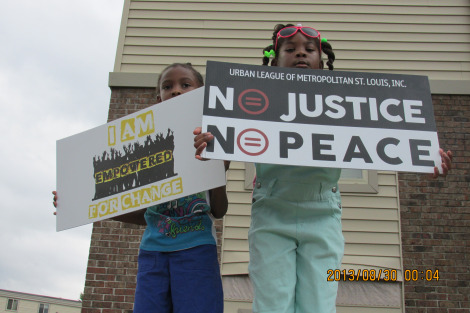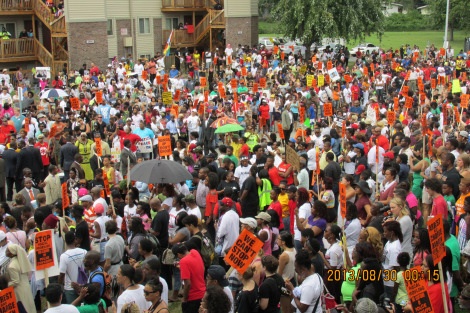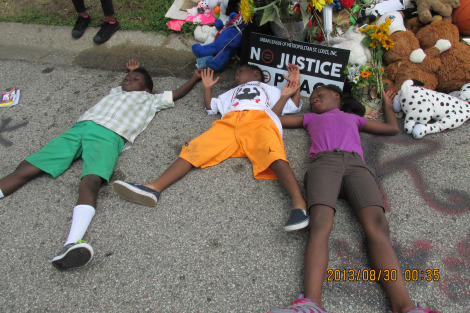Get on the Bus: Inside the Black Life Matters 'Freedom Ride' to Ferguson

It's Saturday, August 30, three weeks after a white police officer named Darren Wilson shot and killed an unarmed, black 18-year-old named Michael Brown in Ferguson, Missouri. A group of about 400 women, men and children--lots of children--are marching down West Florissant Road toward where it meets Canfield Drive, the street where Brown died.

Fruit of Islam members have lined up on each side of the road and joined hands, a formation meant to push protestors out of the center to make room for Brown's family. The crowd responds immediately; they're old pros at this point.
The national media are gone and the police have stopped making drama with tanks, tear gas and rubber bullets. Yet people are still marching. "I couldn't sit back on the sidelines; no more posting and tweeting," black St. Louis native Michael Matlock tells me. "This is the biggest thing I done seen since the Million Man March. We need to be out here supporting."
Lynetta Hayes, another black St. Louisan, is worried about how police might treat her nephews. "They're the same age as Michael Brown and they're right here in this community," she says. "This could have been anyone, any one of our nieces, nephews, any one of our children. It's a trap and it's going on all over the world and it just needs to stop."
***
After about 30 minutes of speeches peppered with biblical references, lots of "hallelujah" and "He is able" from the crowd, and a sudden rainstorm, we make our way to Forestwood Park for a rally. Where I'm standing, in the back, this is an unpopular decision.
"What the fuck are we doing in the park?" a black man of about 20 screams at whoever is listening. "The park didn't kill Mike Brown! The po-lice killed Mike Brown! We need to be at the po-lice station!
The livid young man is victorious: As a man onstage makes a speech about the power of Civil Rights-era demonstrations, a pocket of people in the crowd begin to chant, "Po-lice station! Po-lice station!" Soon, about 50 people begin to march to Ferguson's police headquarters.
***
The group I'm with debates our course. I'm among 42 black people from New Jersey, New York and Philadelphia who have travelled some 21 hours by bus to support organizers in Ferguson and take relevant action back home. Between the iffy air conditioning and the lack of wi-fi and outlets, we bond pretty quickly.
My group is one of many. Us "freedom riders," who include journalists, lawyers, medics, organizers, pastors, students, tech experts and videographers, are participating in an action dubbed Black Life Matters. More than 500 of us have traveled from Boston, Chicago, Columbus, Detroit, Houston, Los Angeles, Nashville, Portland, Tucson, Washington D.C., Winston Salem and other cities to support the people of Ferguson and help turn a local moment into a national movement. Many of us raised money for the trip using GoFundMe.
This afternoon we're supposed to be in St. Louis at St. John's United Church of Christ, strategizing with activists from the Organization for Black Struggle (OBS), Hands Up Don't Shoot and Missourians Organizing for Reform and Empowerment. OBS and Hands Up Don't Shoot have issued a list of local and national demands that include the immediate arrest of Wilson, a special prosecutor to replace the controversial St. Louis County prosecutor, Robert McCullough, and front-facing cameras in police departments with records of racial disparities.
After the session some of us are supposed to canvass Kirkwood, the neighborhood where McCullough lives. Others are scheduled to go to a Ferguson barbecue to spend time with youth activists. But many of us want to march to the police station. After about 10 minutes of chatter, our leader, a 40-something regional coordinator named Monica Dennis, OKs the trek.
Among the folks in my group is Ahmad Greene-Hayes, a Williams College student from Newark. His mom is a retired police officer; his godmother is up for sergeant.* "I wanted to see Ferguson for myself," he says about why he raised $450 online for the ride. "I wanted to see just how much the media can exaggerate, and I'm not talking about social media because I think social media has done a great job with painting the real picture. But I wanted to see how white America, through news outlets, has painted a false narrative about black rage, about anger, about the mobilization of black people."

When we arrive at the police station, we join about 150 black, brown, white and Asian people yelling slogans. There's "Hey hey, ho ho, these racist cops have got to go," "No justice, no peace,""Who am I? Mike Brown!" and the occasional "black power!" As we protest, a row of about five white police officers wearing sunglasses and everyday uniforms stand before us with their hands on their hips or their arms crossed. Unlike the militarized response of previous weeks, this display is ceremonial. Their strategy seems to be to stare at us while we tire ourselves out.
***
I first heard about Black Lives Matter through the Brooklyn-based activist Darnell Moore. The Camden, New Jersey, native sought (and obtained) sponsorship by Race Forward, the racial justice group that publishes Colorlines. Along with Los Angeles organizer Patrisse Cullors and a range of national and local coordinators, Moore planned this four-day trip in two weeks.
"We were just wanting a way to be part of the movement work that's being done and wanting to support folk in Ferguson but to also draw connections between Ferguson and other places across the country," says Moore. "We wanted to let people know that what happened to Mike Brown isn't particular to Ferguson. It's a national problem of state-sanctioned violence against black people."
Throughout the trip Moore, who is a queer, feminist organizer, stresses the importance of solidarity between heterosexual and LGBTQ black folks. "It has historically been the case that racial justice has been only thought to be the work of black men. ... Our history has conveniently invisibilized black women and queer and trans people," Moore explains. "But if the mantra of this trip is 'Black life matters,' it's important to us to emphasize that all black lives matter. This is an opportunity to expand a racial justice framework in an equitable way that includes all of us."
"The two [lead] organizers are queer black folk," he adds. "We are not Bayard Rustin. This is not about us hiding any aspect of our identity."
***
Back at the police station protest, some of us have fanned out to find our youngest rider, Nia Alvarez-Mapp, 17. When she boards the bus calmly eating a Rice Krispy treat, we tease her. When I ask her why she chose to ride she says she's here to confront her fears. "Everyone thinks I'm crazy for doing this, but I don't want to [feel] fear when my back is turned. I find it ridiculous how a young 18-year-old boy, two days away from college, gets shot in the head. It scares me."
 Since protestors are blocking the street, our bus driver makes a risky U-turn. My group rides to the community barbecue, which is taking place in a Ferguson parking lot. This is where members of Lost Voices, a black teen group that has formed in the days since Brown was killed, have been sleeping for weeks. They started out on cardboard boxes; people have since donated tents. On the mic hooked up to a sound truck, one boy announces that he's lost both of his jobs because he was here instead of at work. Another tells the small group of attendees that they plan to stay here until Wilson is arrested. (The next day Lost Voices members find a noose in their camp.) With constant reminders to "turn up," we dance in the parking lot. It's a temporary relief from the tension of the march.
Since protestors are blocking the street, our bus driver makes a risky U-turn. My group rides to the community barbecue, which is taking place in a Ferguson parking lot. This is where members of Lost Voices, a black teen group that has formed in the days since Brown was killed, have been sleeping for weeks. They started out on cardboard boxes; people have since donated tents. On the mic hooked up to a sound truck, one boy announces that he's lost both of his jobs because he was here instead of at work. Another tells the small group of attendees that they plan to stay here until Wilson is arrested. (The next day Lost Voices members find a noose in their camp.) With constant reminders to "turn up," we dance in the parking lot. It's a temporary relief from the tension of the march.
***
In the evening we return to the basement of St. John's United Church of Christ for a group meeting. Organizer Cullors asks us to reflect on the day and Arielle Newton, a young rider from New York, testifies:
I can honestly say that today I truly felt the spirit of what it means to be a black and brown person. The fact that we marched and then we said, 'You know what, let's go to that police station and let's stand there and make sure they hear us and see us ... and feel us'--I am so thankful [for]. Never in my life have I felt so thankful to be a BLACK WOMAN who is ready to go, who is ready to stand with more black women while our voices are heard!"
Later on, the young St. Louisan sitting next to me starts weeping. I know she goes by @Nettaaaaaaaa on Twitter and that she has more than 13,000 followers, but I can't bring myself to interrupt her tears to get her full name or ask her age. Along with two friends she stands up and tells us how they've been protesting since the beginning and that they are exhausted. She also informs us that an out-of-towner (who turns out to be an ex-pimp named Tariq Nasheed) has been tearing her protest work apart on Twitter. She and her friends tell us that they're thankful that we're there but feel possessive of their movement. They urge us to keep Ferguson and Michael Brown at the center, a sentiment I hear from local people throughout the trip.
***

Black Life Matters isn't a religious action but Christianity certainly informs our activities. On Sunday morning we attend service at St. John's United. The pastor, Starsky Wilson, delivers an epic sermon called "The Politics of Jesus."
"Jesus' political climate sounds eerily [similar] to the political climate we find ourselves in today," he preaches during the 22-minute, definitely-worth-watching-on-You-Tube sermon. "Jesus lived under Roman occupation. The Roman occupation seems similar to the police state on the streets of Ferguson that we have seen in the last couple of weeks."After the preaching ends, a 10-year-old rider from L.A. testifies. Standing next to her mom, she tells us that she's afraid of police brutality and wishes she could live without that fear. Terror has been a constant refrain this weekend.
***
The last and most important thing Black Life Matters does before we hit the road is break into groups according to area of expertise and plan at least three local actions we will take. Deadlines are assigned and leaders assure us that we will have accountability partners to ensure that we do the work.
I'm in the Communications group. I halfway cover the session, halfway participate in it. I have to admit that throughout the weekend I've struggled with my role. I wonder if I'm here as a journalist or a participant. During our bus ride home, which lasted 24 hours because someone got sick, I decide that I am an observer and a volunteer and that I will be transparent about my involvement with Black Life Matters.
On the way home, between much-needed naps, I talk to Benjamin Ndugga-Kabuye. He grew up in San Diego after moving to the United States from Uganda as a kid. He works for a Brooklyn-based group called the Black Alliance for Just Immigration and he explains why black immigrants from Africa, the Caribbean and beyond must play a role in the fight against state-sanctioned violence. "We can talk about black immigrants who have also faced that same brutality. I mean, famously, people discuss Amadou Diallo," he says. "When we think about the violence leveled against black bodies, as we think about what motivates it, we've got to bring all black people to this discussion." Ndugga-Kabuye also tells me that Black Life Matters represents something new. "Even though we're gathering for Mike Brown, we've got to think about what that means for other black folk--black women, black queerfolk, black transfolk. We can't just think [theoretically]. We put together the language. Now we've got to practice a politic that encompasses all black people."
***
On Monday, September 1, we arrive in midtown Manhattan at about 2 p.m. We take a group photo with our hands up, the now-universal sign of resisting police and vigilante violence. A few of us joke about seperation anxiety. I chuckle, but I'm serious about it.
On Facebook I friend everyone I recognize from the trip including Reverend Wilson, who is prolific on social media. Throughout the week, tag-filled testimonies begin to appear. Several people (including me) say they can't find the right words to describe our journey. One rider describes a change within: "I felt something shift in me and more importantly, I bore witness to an emergent Black political consciousness and a movement led by our youth."
Another rider speaks about the power of touch: "It's so funny because if you know me, [you know that] hugging isn't always my go-to. But that's all I had to offer while in Ferguson. I had no words...all I knew to do was to embrace, to hold, to hug to love upon."
Throughout the week I've been thinking about something the St. Louis MC and organizer Tef Poe told me at the barbecue. "We ain't scared of the police," he said evenly. "They've lost all power in the situation."
For six days now I've been praying that he's right.
***
For additional takes on the Black Lives Matter journey from New York riders, read Brittney Cooper's Salon column, Arielle Newton's Black Millennial Musings blog, Kristin Braswell's roundup for Ebony.com, Ahmad Greene-Hayes' African Kaleidoscope piece and Tamura Lomax's, Stephanie Troutman's and Heather Laine Talley's piece on The Feminist Wire. For follow-up, read Darnell Moore's and Patrisse Cullors' op-ed at the Guardian.
*Post has been updated to reflect the fact that Ahamad Greene-Hayes' godmother is not running for sheriff. She is up for seargent.
